Choosing the right guitar for you is crucial to achieving ease and comfort in playing. Many renowned guitars on the market are designed with larger-handed players in mind. However, players with smaller hands need not despair; there are high-quality options specifically tailored to suit their needs.
In this comprehensive review, we’ll discuss the best electric guitars for small hands, focusing on crucial aspects like comfort, playability, and sound quality. You’ll learn:
- Why each guitar is suitable for small-handed players.
- The key features and technical specifications of each guitar.
- How each guitar performs and our verdict on it.
We’re confident that by the end of this review, you’ll find the perfect guitar to fit you without compromising on your musical ambitions.
The Best Electric Guitars For Small Hands
- Fender Player Mustang 90
- Ibanez miKro GRGM21
- Jackson Dinky Minion JS1X
- Squier Mini Strat
- Fender American Original ‘60s Jaguar
- Epiphone Power Players Les Paul
1. Fender Player Mustang 90
The gloss finish on the alder body also enhances the guitar’s durability and overall aesthetic appeal.
Fender Player Mustang 90
The Fender Player Mustang 90 presents a sleek and compact design with its smaller-scale neck and iconic offset body shape. Its alder body, maple neck, and Pau Ferro fretboard provide warm and vibrant tones that can be dialed in for a wide array of musical styles.
Why someone should buy: For those with small hands, the Mustang 90’s 24″ scale length makes playing easier without compromising sound quality. The guitar’s pair of MP-90 single-coil pickups deliver a fat, punchy tone that is perfect for rock ‘n’ roll, blues, or jazz.
- Comfortable 24″ scale length
- Versatile MP-90 single-coil pickups
- Unique, iconic offset design
Technical Features:
- Alder body
- Gloss polyester finish
- C shape neck
- 24″ scale length
- Pau Ferro fingerboard
- 22 medium jumbo frets
Review:
The Fender Player Mustang 90 is an exceptional guitar for small hands. The guitar’s shorter scale length and C-shaped neck profile provide comfortable playability. The MP-90 single-coil pickups offer a variety of tones that range from clean to crunchy, perfect for various musical styles.
Verdict:
For players seeking a compact electric guitar that doesn’t sacrifice tone or playability, the Fender Player Mustang 90 is an excellent choice.
This Guitar is Perfect For:
Players with small hands who are looking for a versatile electric guitar that can tackle a wide range of music styles.
2. Ibanez miKro GRGM21
Ibanez guitars are also known for being affordable, making this a great option for beginners who are just starting to play guitar.
Ibanez miKro GRGM21
The Ibanez miKro GRGM21 is a compact powerhouse that packs a punch well above its size. This guitar offers a range of robust tones through its dual Infinity R humbucker pickups and is excellent for those with small hands or beginners seeking a manageable learning instrument.
Why someone should buy: With its shorter 22.2″ scale length, the GRGM21 is easier to play than a full-sized guitar for those with small hands. Moreover, its sturdy Poplar body provides bright and balanced tonal qualities, making it suitable for various music styles.
- Compact 22.2″ scale length
- Dual Infinity R humbucker pickups for a powerful sound
- Maple neck for bright tonal quality
Technical Features:
- Poplar body
- Jatoba fretboard
- Infinity R humbucker pickups
- 22.2″ scale length
- F106 bridge
Review:
The Ibanez miKro GRGM21 offers a comfortable playing experience for players with small hands with its shorter scale length. Its dual Infinity R humbucker pickups provide a punchy, high-output sound that is excellent for rock or metal genres. The guitar’s Poplar body and Maple neck also enhance its sound quality by providing bright and resonant tonal characteristics.
Verdict:
With its robust sound and compact design, the Ibanez miKro GRGM21 is an affordable guitar that’s perfect for those with small hands, beginner players, or seasoned musicians looking for a portable and powerful instrument.
This Guitar is Perfect For:
Players who want a compact and powerful guitar that can deliver robust sound output, especially those inclined towards rock or metal genres.
3. Jackson Dinky Minion JS1X
The speedy neck is also a standout feature, allowing for quick finger movements and slick solos.
Jackson Dinky Minion JS1X
The Jackson Dinky Minion JS1X is a small-sized electric guitar designed for fast play and packed with a big sound. This guitar is ideal for players with small hands due to its 22.5″ scale length and sleek speed neck profile.
Why someone should buy: The JS1X is equipped with two high-output Jackson humbuckers, which deliver a full and driving tone perfect for hard rock or metal. Its poplar body also adds extra resonance to the sound.
- Short 22.5″ scale length
- High-output Jackson humbuckers for big sound
- Speedy maple neck for fast playing
Technical Features:
- Poplar body
- Amaranth fingerboard with 24 jumbo frets
- Two high-output Jackson humbucker pickups
- 22.5″ scale
Review:
The Jackson Dinky Minion JS1X is an ideal guitar for those with small hands or young beginners. Its compact design and short scale length make it comfortable to play, while the high-output Jackson humbucker pickups deliver a big sound that can cover a wide range of musical styles.
Verdict:
The Jackson Dinky Minion JS1X is a fantastic choice for players with small hands looking for a guitar that offers comfort, fast playability, and a big sound.
This Guitar is Perfect For:
This is one of the best guitars for young beginners, players with small hands, or musicians seeking a guitar for quick play and high-output sound.
4. Squier Mini Strat
The three single-coil pickups also offer versatility, providing the classic Stratocaster tones that can be used across a variety of musical genres, making it a great guitar, no matter your style.
Squier Mini Strat
The Squier Mini Strat is a 3/4-size Stratocaster guitar that’s perfect for beginners, young players, and those with small hands. It features all the classic Stratocaster elements, including a poplar body, a maple neck, and three single-coil pickups.
Why someone should buy: With its shorter 22.75″ scale, the Mini Strat offers comfortable playability for those with small hands. The guitar’s three single-coil pickups offer a range of tonal possibilities, from clean and bright to warm and mellow.
- Classic Stratocaster elements in a 3/4-size guitar
- Three single-coil pickups for versatile tones
- Short scale length for comfortable playing
Technical Features:
- Poplar body
- Indian laurel fingerboard with 20 medium frets
- Three standard single-coil pickups
- 22.75″ scale
Review:
The Squier Mini Strat is a great choice for beginners or players with small hands. Its shorter scale length and slim neck profile make it comfortable and easy to play.
Verdict:
If you’re a beginner or have small hands and want the classic Stratocaster experience, the Squier Mini Strat is an excellent choice. It offers comfortable playability, versatile sound, and an authentic Stratocaster feel.
This Guitar is Perfect For:
Beginners, players with small hands, and those looking for the classic Stratocaster experience in a smaller size will love this option.
5. Fender American Original ‘60s Jaguar
The Pure Vintage ’62 single-coil Jaguar pickups deliver the authentic Fender sound, while the lead/rhythm circuit and bass-cut “strangle” switch add versatility to its tones.
Fender American Original ‘60s Jaguar
The Fender American Original ‘60s Jaguar is an electric guitar that combines vintage design with modern playability. It’s great for players with small hands due to its ’60s C-shaped neck profile and slightly flatter 9.5″ fingerboard radius.
Why someone should buy: This Jaguar model features an Alder body with a lacquer finish and two Pure Vintage ’62 single-coil Jaguar pickups, providing an authentic Fender sound. It also includes a lead/rhythm circuit and a bass-cut “strangle” switch, giving players a wide range of tonal options.
- Vintage design with modern playability
- ’60s C-shaped neck profile for comfort
- Wide range of tonal options
Technical Features:
- Alder body
- Lacquer finish
- 2 Pure Vintage ’62 single-coil Jaguar pickups
- Lead/rhythm circuit
- Bass-cut “strangle” switch
- ’60s C-shaped neck profile
- 9.5″ fingerboard radius
Review:
The Fender American Original ‘60s Jaguar perfectly blends vintage appeal and modern playability. Its ’60s C-shaped neck profile and 9.5″ fingerboard radius offer comfortable playing for small hands.
Verdict:
If you’re a player with small hands looking for a guitar that combines vintage style with modern features, the Fender American Original ‘60s Jaguar is a solid choice.
This Guitar is Perfect For:
Guitar players with small hands who love vintage designs and versatile sound options will appreciate this model.
6. Epiphone Power Players Les Paul
The SlimTaper™ D profile neck and 22.729″ scale make it comfortable for players with smaller hands, and its reliable tuning stability means less time tuning and more time playing.
Epiphone Power Players Les Paul
The Epiphone Power Players Les Paul is a stunning guitar that merges classic design elements of the iconic Les Paul with user-friendly features suited for newer and younger players. Boasting a sturdy body, SlimTaper™ D neck profile, and a 22.729″ scale length, this guitar is manageable for players with small hands. The Epiphone humbuckers™ deliver rich and full Les Paul tone, while the guitar’s overall design ensures it stays in tune for extended periods.
Why someone should buy: With the Epiphone Power Players Les Paul, beginners can start their journey with a guitar that not only fits their hands but also delivers performance and aesthetics. Experienced players, on the other hand, can enjoy a compact, reliable guitar for travel or practice sessions.
- Classic Les Paul design elements in a compact form
- Epiphone humbuckers™ offer rich, full Les Paul tone
- Reliable tuning stability
Technical Features:
- Mahogany body
- Gloss finish
- SlimTaper™ D profile neck
- Laurel fingerboard
- Epiphone 650R and 700T Humbucker pickups
- 22.729″ scale
- 12″ fingerboard radius
Review:
The Epiphone Power Players Les Paul is a guitar that packs a punch in a compact package. Its solid mahogany body and Epiphone humbuckers™ work together to deliver the rich, full tone synonymous with Les Paul guitars.
Verdict:
The Epiphone Power Players Les Paul is a fantastic choice for players looking for a reliable, comfortable, and tonally rich guitar. Its compact size does not compromise its ability to deliver the much sought-after Les Paul tone.
This Guitar is Perfect For:
Beginners and experienced players seeking a comfortable, small-handed guitar without sacrificing the iconic Les Paul sound will love this model.
Buyer’s Guide: Choosing the Best Electric Guitar for Small Hands
Navigating the world of guitars can be complex, particularly when you’re seeking the best electric guitar for small hands. There is a world of electric guitar brands out there, and it can be difficult to know where to start. The instrument’s design, structure, and size can all impact your playing experience.
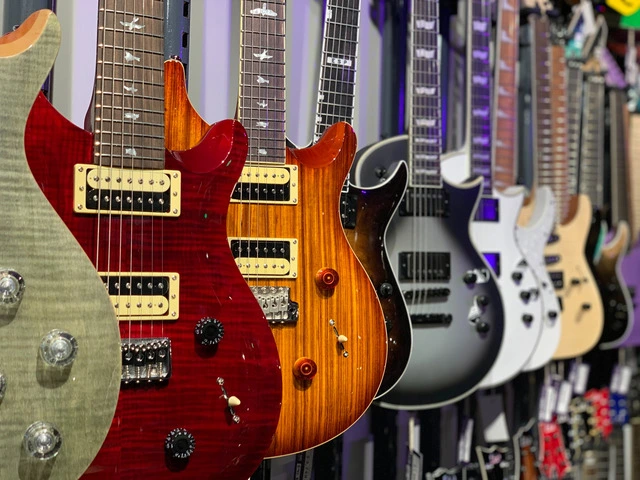
Neck Profile and Width
The neck profile and width are critical factors in a guitar’s playability, especially for those with small hands. Here, we’ll delve into the implications of neck design and how you can choose a guitar neck that accommodates your hand size and playing style.
Understanding Neck Profile: Neck profile refers to the shape of the back of the guitar neck, where your thumb rests as you play. Common neck profiles include the C-shape, V-shape, U-shape, and D-shape, each offering different levels of comfort and playability based on hand size and playing style.
C-shape: This is the most common profile found on modern guitars and is often the most comfortable for small hands. It’s round and slim, allowing for easier chord formations and improved playability up and down the neck.
V-shape: The V-shape profile is less common and might require some adjustment. However, some players find that the pointed center of the “V” allows for a more relaxed grip, especially if you’re used to keeping your thumb low on the neck.
U-shape and D-shape: These profiles tend to be chunkier and may pose a challenge for players with smaller hands. The U-shape has higher sides, while the D-shape is flatter on the bottom, which may hinder comfortable maneuvering around the fretboard for those with shorter fingers.
Neck Width: The width of the neck, often referred to as the nut width, is the distance from one side of the fretboard to the other at the top of the neck (closest to the headstock). Traditional classical guitars usually have a wider nut width (around 2 inches), which allows more space between the strings for intricate fingerpicking. In contrast, most electric and steel-string acoustic guitars feature narrower necks (generally 1.68 to 1.75 inches) which are more comfortable for small hands, requiring less stretching between the thumb and fingers.
Radius: The fretboard or fingerboard radius refers to the curvature of the fretboard across its width. A smaller radius (7.25″ to 9.5″) means a more curved fretboard, making it easier for small hands to grip chords. A larger radius (12″ to 16″ or even flat) provides a flatter surface, often preferred for soloing and modern play styles.
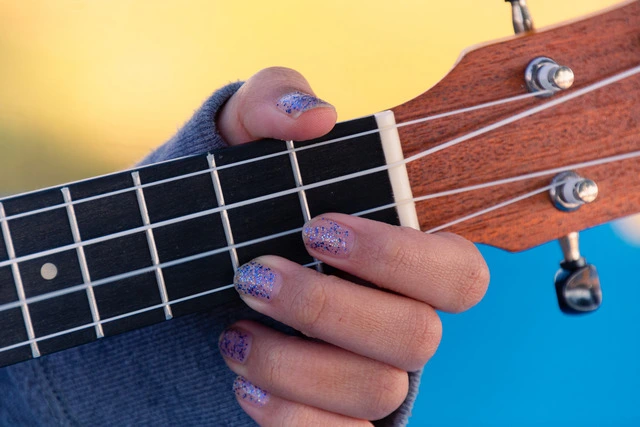
Scale Length
Scale length, otherwise known as the distance between the nut and the bridge of the guitar, affects the spacing between the frets and the string tension.
Shorter scales result in closer fret spacing, easing navigation on the fretboard for players with small hands. They also reduce string tension, making the strings easier to press down. Guitars with a scale of around 22.5″ to 24.75″ are generally more comfortable for players with smaller hands. Shorter scales also tend to yield a warmer, less bright tone which might be desirable depending on your genre preference.
Body Size
The size of the guitar’s body can influence playability, especially for individuals of a smaller stature or younger age.
Compact body designs are more comfortable to handle and play. Several guitar models cater to this need, like the Squier Mini Strat or the Ibanez miKro series, featuring smaller bodies without compromising sound quality. Moreover, guitars with a cutaway design can provide easier access to higher frets.
String Spacing
The distance between the strings can significantly affect playability.
Narrower string spacing often suits players with smaller hands, particularly when forming chords or playing intricate fingerstyle patterns. However, it’s important to balance comfort with playability – excessively narrow string spacing may lead you to mute adjacent strings unintentionally.
Setup and Action
The guitar’s setup, including action or string height, can greatly influence playability.
Lower action reduces the finger pressure required to fret notes, making the guitar easier to play. However, action that’s too low may result in fret buzz – a buzzing noise that occurs when the strings vibrate against the frets. It’s critical to strike a balance or have a professional set up your guitar to ensure optimal action.
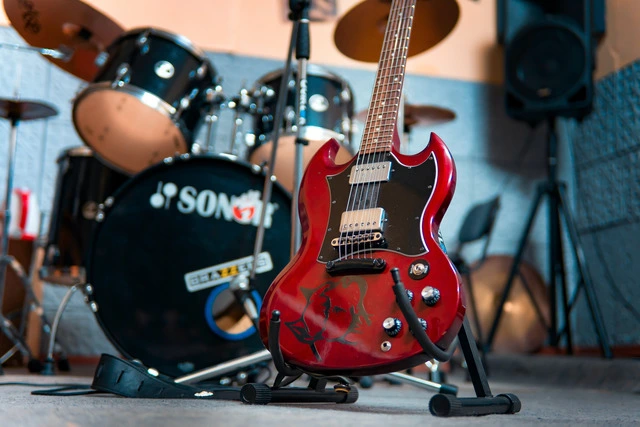
Quality of Craftsmanship
A well-crafted electric guitar isn’t just aesthetically pleasing—it also promises longevity, superior sound quality, and smooth playability. Here are key elements to consider:
Body and Neck Construction: Electric guitars generally have either a bolt-on, set-in, or neck-through-body construction. Bolt-on necks are common in less expensive guitars. They’re quite sturdy and offer a snappy, bright tone. Set-necks are glued to the body and are typically found in higher-end guitars, producing a warmer tone with better sustain. Neck-through constructions offer the best sustain and stability but are usually found in more expensive guitars. Regardless of the type, the joint should be neat and tight, with no visible gaps.
Quality of Woods: The type and quality of wood can greatly affect the sound, feel, and overall quality of the guitar. Mahogany, for instance, is known for its warmth and is commonly used for bodies and necks. If you’re looking for something with depth, look for a model with a mahogany neck. Maple is a harder wood often used for necks and tops for its bright tone and sustain. Rosewood and ebony are common for fingerboards due to their smooth feel and durability. The wood should be free of knots, cracks, and other defects.
Frets: Frets should be well seated and smooth with no sharp ends, and they should not be loose or uneven, as these issues can affect playability and intonation.
Finish: A good finish not only enhances the aesthetic appeal of the guitar but also protects the wood. The finish should be even and free from drips, bubbles, or rough spots.
Hardware: The quality of hardware such as tuners, bridges, and pickups is essential. They should operate smoothly and feel sturdy. Cheaper hardware can degrade quickly, affecting sound and playability.
Electronics: The electronics of the guitar, including the pickups, controls, and wiring, should be well-installed and of good quality. Poor-quality electronics can result in noise, volume imbalance, or a thin tone. There are a range of guitar pedals available that can help you sculpt your tone.
Setup: A well-crafted guitar should also come with a professional setup. This includes proper adjustment of the neck (truss rod), action (string height), intonation (tuning accuracy along the fretboard), and pickup height.
Remember, a higher price tag doesn’t always guarantee better craftsmanship. Sometimes, lower-priced guitars can surprise you with their quality, while some expensive models might disappoint. It’s essential to thoroughly check each element, try out the instrument, and, if possible, get a second opinion from a knowledgeable friend or professional.
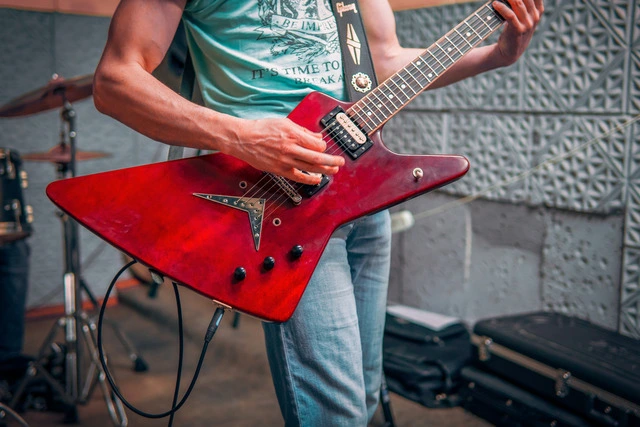
Sound and Electronics
Electric guitars are unique in that they rely heavily on their electronics to shape and amplify the sound. Here are some of the key factors that contribute to the sound and electronics of an electric guitar:
Pickups: Pickups ‘pick up’ the vibrations from your strings and convert them into an electrical signal. This signal can then be amplified. There are three main types of pickups: single-coil, humbucker (double-coil), and P-90. Single coils are known for their bright, clear tones, while humbuckers offer a warmer, fuller sound ideal for classic rock and metal. P-90 pickups provide a tone that’s somewhat a middle ground between single-coils and humbuckers. The number and type of pickups on a guitar and their positioning will have a major impact on the guitar’s tone.
Tone Controls: These controls allow you to adjust the treble and bass in your sound. Many electric guitars come with a tone control for each pickup, allowing you to customize your sound even further.
Volume Controls: Like tone controls, many guitars will have a volume control for each pickup. This allows you to balance the output from your pickups when more than one is active.
Pickup Selector: This switch allows you to choose which pickup(s) are active. This can greatly change the sound of your guitar. For example, the neck pickup usually produces a warmer tone, while the bridge pickup tends to be brighter and sharper.
Amplification and Effects: Electric guitars are designed to be used with an amplifier, which will have a huge impact on the overall sound. The type of amplifier, its settings, and any effects used (such as reverb, distortion, delay, etc.) can significantly change the character of your guitar’s tone.
Output Jack: This is where you connect your guitar to an amplifier using a 1/4″ cable. The quality of the output jack and cable can affect the signal quality.
Wiring: This is often overlooked, but the quality of the wiring inside your guitar can affect your tone. Poor soldering or low-quality components can result in unwanted noise or loss of signal.
Wood and Construction: While not part of the ‘electronics,’ the type of wood used and the overall construction of the guitar will have a significant impact on the sound. Different woods have different tonal characteristics, and the guitar’s design can affect sustain (how long a note rings out) and resonance.
As you can see, the sound and electronics of an electric guitar are a complex, interconnected system. It’s important to understand how these elements work together to create the overall sound of the guitar, so you can make informed choices when choosing the best electric guitar for small hands.
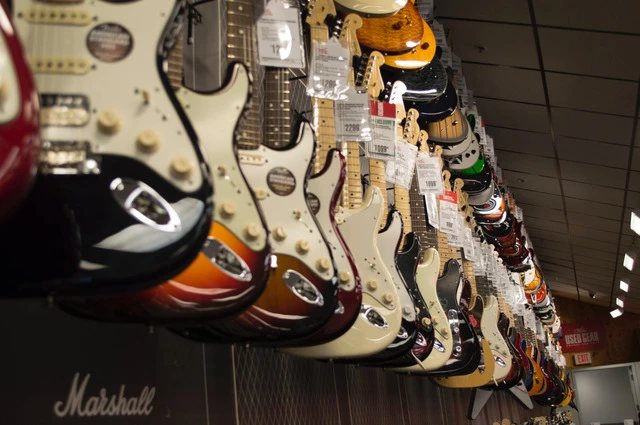
Maintenance Tips for Guitar:
Keeping your guitar in good shape is crucial to ensuring its longevity and optimal sound quality. Below are a few maintenance tips specifically tailored for your electric guitar:
Regular Cleaning: Guitars, like any other instrument, must be cleaned regularly. This includes wiping down the strings after each use to remove oils and dirt that can degrade them over time. Use a dry, lint-free cloth for this.
String Changing: Depending on your playing frequency, strings should be changed every 1-3 months. When you change your strings, it’s a great opportunity to clean your fretboard. Use a specially designed guitar cleaner and a soft cloth to clean the fretboard.
Proper Storage: When not in use, store your guitar in its case, away from direct sunlight or extreme temperatures. This protects it from dust and helps prevent warping due to heat or moisture.
Regular Check-ups: Have your guitar professionally set up every 6-12 months. This usually includes checking the neck relief, string action, and intonation, ensuring your guitar plays its best.
Polishing: Regularly polish your guitar, but be cautious about the type of polish you use. Avoid silicone-based polishes, as they can cause complications if you ever need to get your guitar refinished.
Humidity Control: Especially important for acoustic guitars but also relevant for electrics, controlling the humidity where your guitar is stored can help prevent warping or cracking. The ideal relative humidity is around 45-55%.
Guitar Accessories for Small Hands:
Guitar accessories can significantly enhance the playing experience, particularly for those with small hands.
Capos: A capo is a device that clamps down across the guitar’s fingerboard at a particular fret. Capos shorten the neck length and can make playing some songs easier for people with small hands.
Straps: A good strap is essential. It allows you to hold the guitar in a comfortable position, which can help improve reach over the fretboard. Some straps are designed with extra padding for added comfort.
Thumb Picks: These can make plucking the strings easier and decrease the hand stretch needed for certain chords. They can be particularly helpful if you’re finding it difficult to hold down multiple strings at once.
Finger Exercises Tools: Various devices can help increase your finger reach and dexterity. For example, finger exercisers have individual buttons for each finger, providing a workout specifically targeted at guitarists.
Nylon Strings: If you’re a beginner with small hands, you may find nylon strings easier to press down than steel strings. While not typical for electric guitars, some hybrid models can accommodate nylon strings.
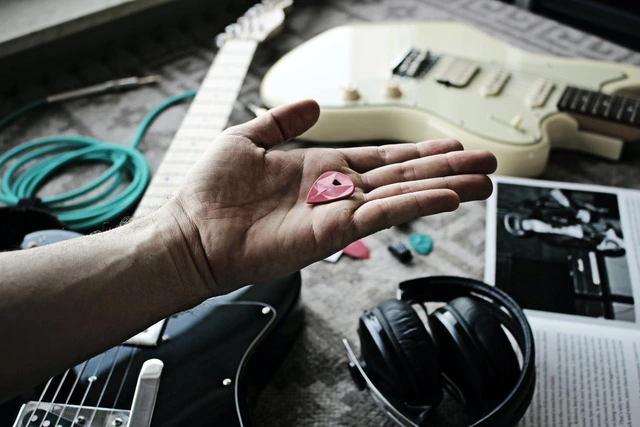
Remember, the key to playing guitar comfortably and effectively, regardless of hand size, is practice and the correct use of tools and accessories that work best for you.
Exploring Other Types of Guitars
Full-sized guitars may not always offer the most comfortable playing experience for those with small hands or shorter fingers. However, the world of stringed instruments is diverse and plenty of alternatives are available. Here are a few worth considering:
Travel Guitars: These are compact guitars designed for easy transportation, but they also serve as an excellent choice for individuals with small hands. Their reduced scale and size make them easier to handle and play. For instance, the “Martin Backpacker” or “Taylor GS Mini” are popular travel guitars praised for their quality and sound despite their small size.
Three-Quarter Size Guitars: Three-quarter size guitars, sometimes referred to as 3/4 size, are essentially smaller versions of full-size guitars. They maintain similar proportions to their larger counterparts, but everything is scaled down to 75% of the original size. This makes the frets closer together, the neck thinner, and the body smaller.
Parlor Guitars: These are smaller-bodied guitars known for their focused, intimate sound. They are ideal for fingerstyle playing and can be easier for those with smaller hands to navigate due to their shorter necks and smaller bodies.
Classical Guitars: Classical guitars often feature wider fretboards but with a flat profile, which can sometimes make them easier to play for those with small hands, especially when forming chords. They also utilize nylon strings, which are softer and easier to press down than steel strings. A popular model is the “Yamaha C40” for its blend of affordability and quality.
Alternative Stringed Instruments: If you’re open to broadening your musical horizons, you might want to consider other stringed instruments known for their smaller and more manageable sizes. For example, the ukulele, with its soft nylon strings and compact size, is a popular choice for those finding the guitar a little too much to handle.
Remember, the type of guitar or instrument best for you ultimately comes down to personal preference. Playability, sound, and comfort should always take precedence over the aesthetics or popularity of an instrument. Always try before you buy, if possible, to ensure you’re choosing the best instrument for your needs.
Finding the Best Electric Guitar for Small Hands: Frequently Asked Questions
Is the electric guitar easier for small hands?
Yes, certain models of electric guitars can indeed be easier for small hands. Due to their thinner necks and smaller bodies, electric guitars often require less finger stretching, making them ideal for people with smaller hands. In this review, we have specifically focused on the best electric guitars for small hands to help narrow down the options.
What is the easiest guitar to play with short fingers?
The Ibanez miKro GRGM21 is an excellent option for players with short fingers. Its shorter scale length, smaller body, and thinner neck profile make playing guitar easier and more comfortable.
What size guitar is best for short fingers?
For players with short fingers, guitars with a shorter scale length (the distance between the nut and the bridge) are typically more comfortable. The Fender Player Mustang 90 and the Epiphone Power Players Les Paul, with their shorter scale lengths, are examples of guitars that are more manageable and comfortable for players with short fingers, making playing guitaran enjoyable experience.
Is a Stratocaster good for small hands?
Yes, particularly the Squier Mini, which features a smaller body and a shorter scale length than a standard Stratocaster. This design makes it one of the best electric guitars for small hands, providing comfort and ease of playing.
Is a Les Paul better than a Strat for small hands?
Both Les Paul and Strat-style guitars can be suitable for small hands, depending on their specific models. For instance, the Epiphone Power Players Les Paul is a great choice due to its smaller size and easy playability. However, the Mini Strat also offers a comfortable and manageable option for those with small hands. Both these guitars are included in our guitars for small hands list due to their unique features and designs that cater to small-handed players.
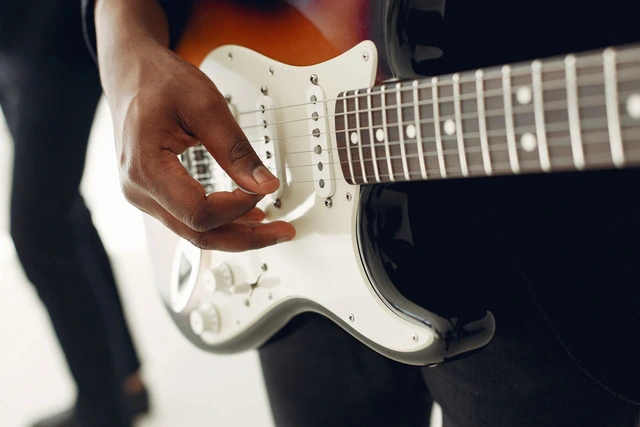
Conclusion
Whether you’re a beginner embarking on your musical journey or an experienced player seeking the perfect fit, finding the best guitar for small hands can open up a world of comfort and ease in your playing. With an understanding of essential factors like the neck profile, fret size, scale length, and quality of craftsmanship, you’ll be able to make a well-informed decision tailored to your needs.
This comprehensive guide has explored the top electric guitars suited for small hands, delved into what makes a guitar accessible for those with a smaller reach, and provided valuable insights into the maintenance and enhancement of your guitar-playing experience. Remember, it’s not just about size. Each guitar possesses its own unique tonal character, playing feel, and aesthetic appeal.
From the versatile Fender American Professional Stratocaster with its slim “Deep C” neck profile to the compact and stylish Epiphone Power Players Les Paul with its legendary tone, the perfect guitar is out there for every player, regardless of hand size. Consider factors beyond size, such as sound, style, and personal preference to truly connect with your instrument.
In the end, the best guitar for you is one that you can’t wait to pick up and play, one that inspires creativity, and one that feels like an extension of yourself. So, explore, experiment, and find that perfect fit to express your musical voice. Happy playing!








